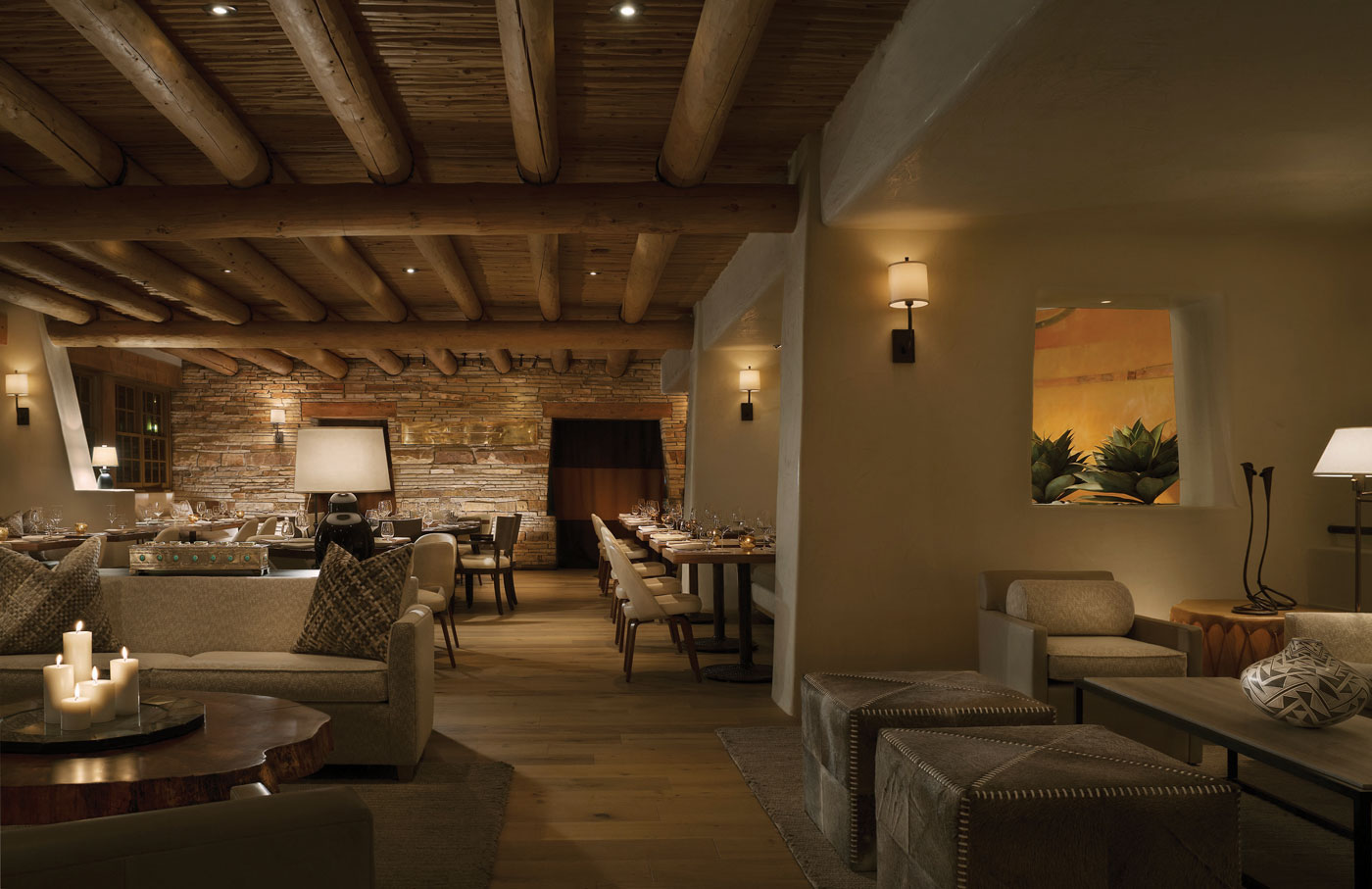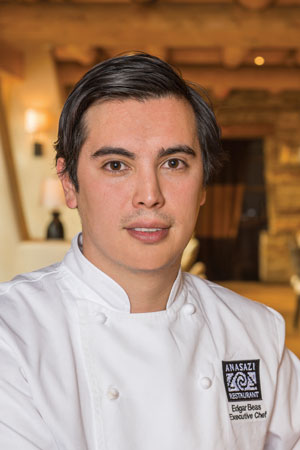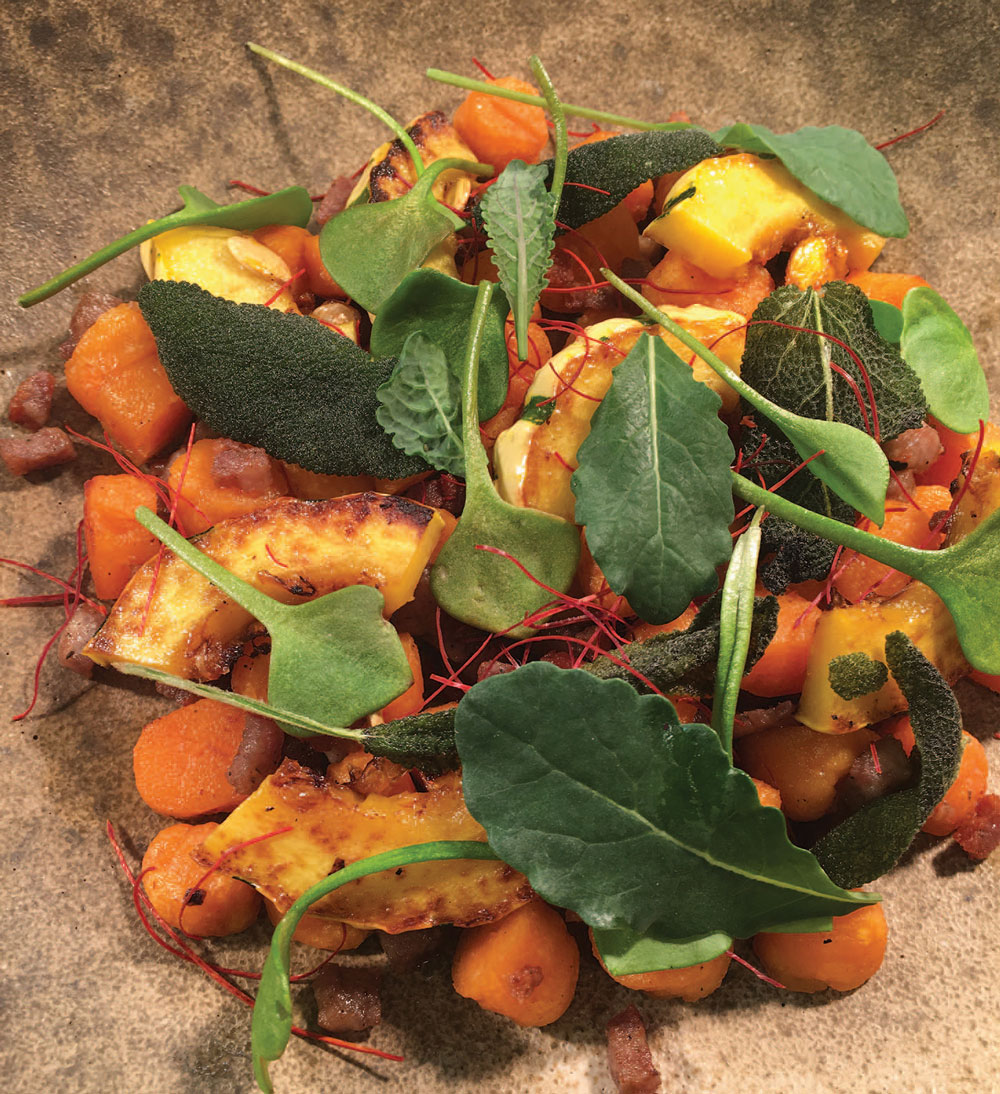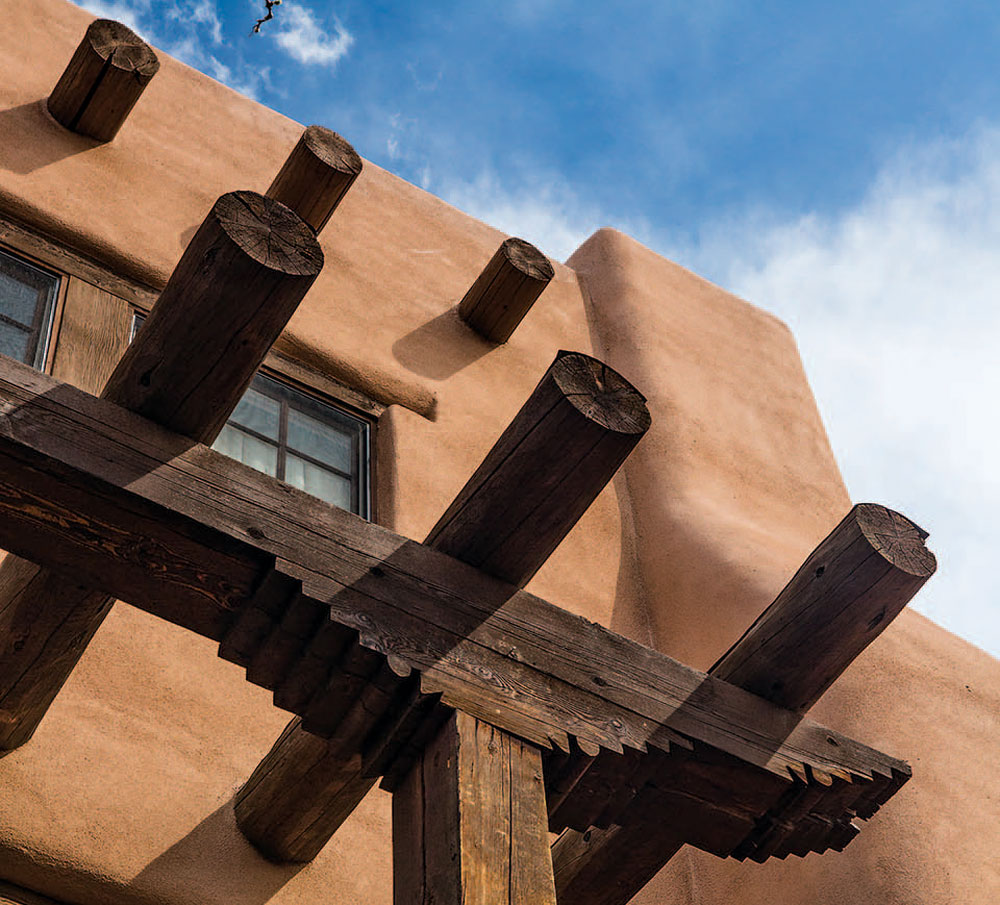Photography: Courtesy Rosewood Hotels & Resorts
At Rosewood Inn of the Anasazi, chef Edgar Beas blends the City Different’s indigenous roots with a taste of the modern Southwest.
A historical marker stands at the end of the Santa Fe Trail. Across the street from the important spot sits the Rosewood Inn of the Anasazi, a boutique hotel that has staked its reputation on place. And like Santa Fe, the Anasazi has evolved. Most recently that’s included a two-year renovation, which brought in works by local artists and a 70-deep tequila program to the Anasazi Restaurant. A hearty agave spirits list isn’t the only update to the hotel’s restaurant-bar. The dining room was opened up, giving the main space a more welcoming feel. A raw-wood partition separates — almost inconspicuously due to its size and the warm lighting — the main space from a lounge-inspired nook and the dedicated tequila bar. Finally, there’s a new chef calling the shots.
Edgar Beas took over the kitchen, moving from Madera, the Michelin-starred restaurant at Rosewood Sand Hill in Menlo Park, California, just before the Anasazi’s 25th anniversary. He had to hit the ground running, considering there were some necessary adjustments to his culinary approach based on locale. At Madera, Beas was responsible for developing new vegan and gluten-free dishes using the region’s seasonal bounty. Before that gig, Beas, 29, was the executive chef at Chez Papa Resto in San Francisco. Almost everything is available year-round in California, Beas told us during a recent phone conversation.
“There are many ingredients used in Santa Fe that are unique,” he says. “In Northern California, chefs are creating unique and interesting dishes, but I think the dramatic change of season here is something that doesn’t really happen in San Francisco because of the climate change. So we have a little bit more to work with season by season in Santa Fe. There is more of an opportunity to work with local game, and in the winter I have to adapt to using more local grains. It’s very, very different than in California.”
Beas was quick to establish relationships with local producers, to begin foraging for ingredients in the Santa Fe area, and to delve into the culinary traditions — indigenous, historical, and contemporary — of New Mexico. But he’s done so with a nod to his classical training and time at Martín Berasategui Restaurant in Spain during the country’s revolutionary modernist cuisine period. The culmination of that formative experience can be seen in such dishes as the venison tortellini with chile threads. (More on that later.)
We spoke with Beas about everything from his approach to cooking to the importance of using local ingredients to what’s new at the Anasazi.

Cowboys & Indians: You have quite the culinary pedigree. How did it lead you to the Rosewood Inn of the Anasazi Restaurant?
Edgar Beas: I think I was selected for the job because of my knowledge of high-end Latin cuisine and because of my experience with farm-fresh ingredients. The restaurant here has an amazing reputation, and it was an honor to be chosen for this role. I’ve had the privilege of working with some very good chefs, such as Chef Martín Berasategui. There has been a lot of technique- and creative-driven cooking in my past but also respect for the land. The Anasazi Restaurant is really a culmination of all my years of training. But I still try to adapt to the area around me while paying homage to what I’ve learned in the past. Here, I can honor Native people by using their native cooking techniques, such as smoking with whatever branches are available. There are a lot of orchards up here. There’s a lot of peach and apple, and pinyon is pretty dominant up here, too. It’s really neat to smoke what branches are floating around and learn what flavors they impart. It’s more eccentric.

C&I: How quickly did you reach out to area growers and producers to establish relationships?
Beas: The first thing that was really important to me was to continue and also to expand upon the local program at the Anasazi. But it took me a couple of months to develop a relationship with the local farmers. I reached out immediately, but because most of the farms are about an hour north of Santa Fe itself, the process took some time. As I was talking to one farmer, and then when another realized what I was trying to do, everybody started to jump on board, and it was a pretty easy transition. It depends on the time of the year, but ... at peak season, I think we were working with at least 20 local farms. Throughout the winter, that number is naturally going to go down because not everybody has greenhouses up here.
But in the winter, we can still get beautiful roots, chickens, and eggs from farmers nearby, and that’s something important to me. I think just having that relationship with the local farmers is very important, not only for my cuisine, but for local business. If I really wanted to, I could get everything from abroad, but that just doesn’t make sense if where you’re at there is an abundance of produce.

C&I: You’ve added to the Anasazi bar menu, elevating it in some ways with dishes like green chile jam and pickled beef tongue. Can you tell us about those dishes and how they fit into your vision of the restaurant?
Beas: The bar is a little more casual, obviously. But we’ve still tried to make it a more fun and interesting experience. I make the chile jam as a garnish to the buffalo sliders. Pickled beef tongue was on the menu, but we’ve since changed the menu. I regularly change menus, keeping them relevant to the ingredients we have available.
When the restaurant was renovated [in 2015], we extended the bar area. So, we wanted the bar menu to offer a similar casual, approachable feel. It gives people access to casual food, but with little hints of innovative techniques or different ingredients.
C&I: Is there a dish that you brought with you from Madera?
Beas: No, not exactly. What we talked about earlier is the inspiration I get from working with local ingredients. I am trying to get away from seafood out here because we’re landlocked. Maybe my octopus dish is the most similar to a dish from Madera. Everywhere I go, I try to take the grilled octopus dish. But I always change the garnish around. It’s something I’ve really enjoyed. It’s all in how you cook it. It can be a little tricky trying to cook it. I try to use the ingredients here and use local spices and ingredients from New Mexico, but with more of an Anasazi flair.

C&I: So would you consider the octopus your signature dish and your favorite ingredient?
Beas: I enjoy the lamb a lot, too. And lamb is super predominant in New Mexico, and I work with a local lamb farmer. I get whole lamb carcasses. I just don’t buy the rack, you know. And then working with local farmers here, it’s a little easier to buy the whole animal. They kind of appreciate that. Because if I just want to order racks, they have to butcher, I don’t know, five lambs for me to get 10 racks. So I think that’s signature, that we use the whole animal.
C&I: On the venison tortellini entree with butternut squash and melted leeks, you list chile threads as a component. What are chile threads? How do you thread chiles?
Beas: Yeah! Chile thread is basically a julienned, cut-paper-thin chile. After you cut them, you blanch them and dehydrate them overnight. It’s another kind of an element like Old World food that’s, out here, more of a near-modern approach. They’re delicious, they’re easy to do, but they’re a little something more creative. But I guess I kind of work with ingredients that are native here and just try to enhance them.
C&I: So is that one of the ways you like to surprise your cooks and your customers?
Beas: Yes. It’s an inspiration: How can you think outside the box when you develop something? Obviously, the first thing in the dish is it has to be flavorful. Also, the menu changes very frequently because of availability. There are some ingredients I can only have for one week out of the year. Like green strawberries — I had them for like a week, you know, and then they were done. Obviously, I can buy them from California, but that’s not what I’m trying to do here. It’s a challenge for the kitchen, for me, for my staff, for the cooks just having them think out of the box. I teach cooks a level of respect for any new ingredients that they have not used in the past. It’s an interesting moment for staff when they realize how abundant and special Northern New Mexico is and all that it has to offer.
Recipes
Jerusalem Artichoke Salad and Venison Gnocchi
For more information or to make reservations at the Rosewood Inn of the Anasazi Restaurant, visit the hotel’s website.
From the February/March 2017 issue.














